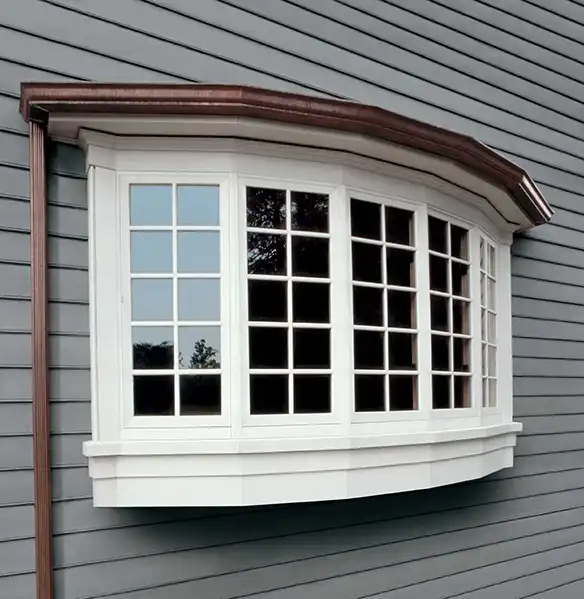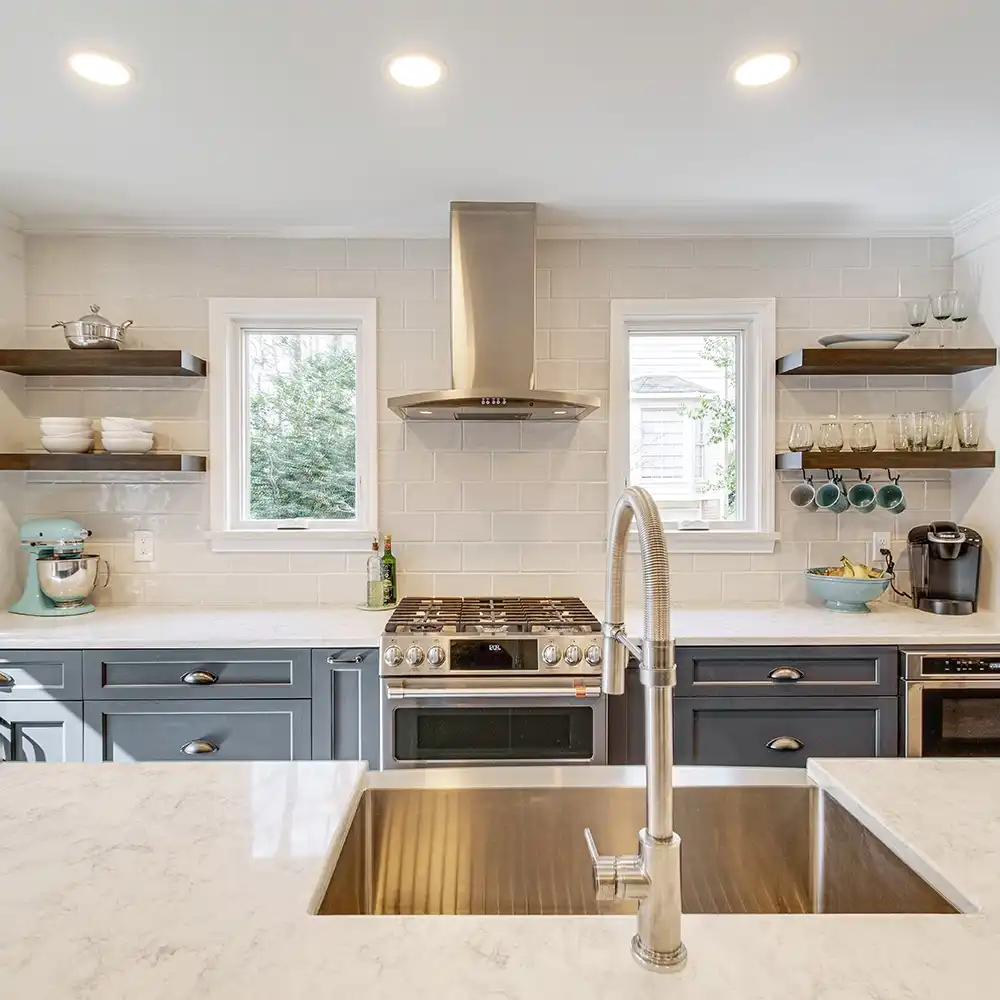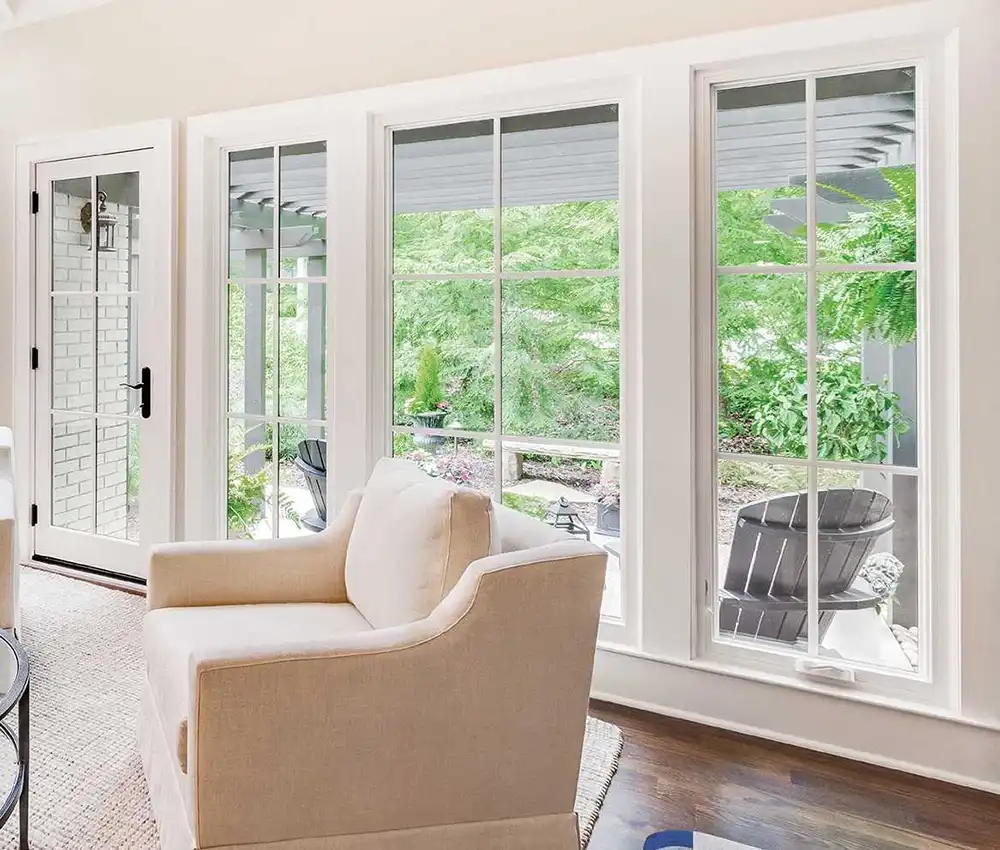
11 March 2024
What is a Casement Window? Styles + Types to Know
Thinking about replacing casement windows? Not sure what sets a casement window apart from other window styles? Learn more about how casement windows can fit into your home.
Casement Window Definition
A casement window is a window that has one or more hinges on the side of the frame. They open and close by turning a crank handle that turns gears to move the window outward and inward. Casements open to the right or to the left. They often come in pairs, also known as double casement windows.
Casement Window Parts
Casement windows have unique window parts because of their hinged design. They have an operating arm that works with the crank handle to open and close the window. There is also a locking handle to latch the window shut.

Head Jamb: The head jamb is the top component of the window frame.
Locking Handle: The handle or lever-operated lock. When pushed closed, locking handles pull a sash tight to the frame. The locking handle provides improved security and energy efficiency.
Operating Arm: An operating arm attaches to both the window frame and the sash. It works with the operating handle to open and close a sash. It also holds a sash in place when opened.
Operating Handle (Crank): The operating handle on a casement window rotates to open and close the window. Turning the crank in one direction moves the operating arm to open the window. Turning the crank handle in the other direction closes the window.
Side Jamb: Side jambs are the vertical components of the frame.
Sill: The sill is the bottom component of the frame. The outside edge of the exterior part of a window sill tapers down to help shed water.
Pros and Cons of Casement Windows
There are many benefits of casement windows. They fit well in narrow spaces to bring natural light and fresh air. You can also style casement windows to match your home’s architecture by adding divided lites or window grids.
Casement Window Pros
Expanded views: Casement windows offer clear views, unlike single hung, double hung, and slider windows. Those windows feature a check rail in the middle to interrupt your vision. You don't have to tilt your head to watch backyard wildlife through casement windows.
Airflow: Casement windows rank near the top of the list of the best windows to improve air circulation. Since casement windows open outward you can bring fresh air into your home from two angles. A casement window can funnel a crosswind into your home when opened at an angle. Or you can open it completely for a direct breeze to pass through.
Easy cleaning: Marvin Replacement makes cleaning casement windows simple with our Easy Wash® hinge. The hinge leaves a gap between the frame and the sash, when opened. The gap allows you to clean the exterior side of the window from inside your home.
Clear View® Hinge: If you value your outside scenes more than convenient cleaning, you can pick our Clear View hinge. The hinge sits at the frame edge for a wider sight out your window.
Multi-point locking system: Our multi-point casement window lock seals out unwanted air and weather. The extra locks provide peace of mind that your windows will remain closed.
Easy to open: Our tuckaway handle makes opening casement windows as easy as turning the crank. The handle extends out so you can open and close the window. When not using it, the handle tucks away to not interfere with your window blinds. Having a handle that extends out makes casements ideal in difficult-to-reach spots.
Tight seal: The multi-point locking system helps pull a casement window sash tight to the frame. It helps limit the paths for wind and water to enter.
Casement Window Cons
Need space to swing open outside: Casement windows need space to operate. That can mean trimming shrubs back from your home’s exterior.
A/C units won’t fit: Since casement windows are taller than they are wide, it’s hard to fit a window air conditioner in them. Double hung or slider windows can fit A/C units better.
Types of Casement Windows
Casement windows come in several styles and sizes. You can pair casement windows together to create bay or bow windows. You can also add a casement picture window between two casement windows for a panoramic view.
Casement Picture Window
A casement picture window is the middle window of a three-window assembly. Casement windows flank each end of the picture window. A casement picture window extends sightlines and allows fresh air to enter from the operable casement windows. They can allow more natural light into your home with a wider area than casement windows alone.

Casement Bay Windows
Marvin Replacement features casement bay windows, which have three casement windows mulled together. You can choose an operating casement window for the center unit or a picture window. Casement bay windows jut out from your home. The flanking windows can sit at 30° or 45°.

Casement Bow Windows
Casement bow windows curve gracefully out from a home for a unique architectural look. Marvin Replacement Bow windows feature four, five, or six casement windows mulled together. You can choose to have all open and close or only the end windows. You can also customize a bow window to feature wider middle windows.

Casement Egress Windows
Casement windows often serve as egress windows. They can have large openings to meet egress window code.


View Replacement Casement Windows
Browse the Marvin Replacement collection of casement window colors, divided lite patterns, and more to picture how they will look in your home.
Casement WindowsCasement Window Sizes
Marvin Replacement custom sizes every window. Our largest casement window sizes range as large as 40-inches by 60-inches or 36-inches by 86-inches. Casement picture window sizes can stretch to 86-inches wide or tall.
Casement Window Screen
Our casement windows have screens that sit in your home’s interior. We have two screen options: our standard Marvin Bright View™ and our Hi-Transparency screen. Both screens have a coating that repels water and resists dirt and grime for sharp, vivid sights. The Bright View screen has 20% increased airflow than a standard screen mesh. The Hi-Transparency screen has a finer and tighter weave than the Bright View screen. It offers better clarity, 25% more airflow, and protection against smaller bugs.
Best Places for Casement Windows
With their taller design, casement window fit in a variety of spaces throughout a home. The crank-handle design makes them ideal where you must reach over obstacles to open a window. The handle extends out, making it easier to reach. Casement windows often appear in kitchens, bathrooms, living rooms, and bedrooms.
Casement Window over Kitchen Sink
Casement windows are some of the best kitchen windows. They fit perfect above a kitchen sink because they’re easy to open and close. A double hung window could create strain as you reach over the sink to open and close it. Comparing a casement vs. a double hung window, a casement window opens with the easy turn of the handle in the kitchen. The ventilation casement windows offer helps move heat out of the kitchen. They can also clear out the scent of any cooking mishaps.

Bathroom Casement Windows
Bathrooms need proper ventilation because of the humidity a shower produces. Casement windows are among the best bathroom room windows. A casement window opens wide to vent a room well. A bathroom casement window works especially well because you can control airflow. You can also choose window features and options, like decorative glass for privacy.

Living Room Casement Windows
Unobstructed viewing areas make casement windows ideal for living rooms with picturesque scenes. Living rooms can use casement bay and bow windows for sweeping vistas. A casement picture window adds room for warming and invigorating natural light to envelope you on a lazy day.

Bedroom Casement Windows
Casement bedroom windows have the advantage of allowing just the right amount of a breeze in. Crank a casement window wide open or just a crack to get the right amount of cool morning wind to wake up refreshed. You can also enjoy the fresh outdoor smells of dewy grass and flowers blowing in.

FAQs
Are casement windows more energy efficient?
Casement windows create a tight seal with their latching lock system. The tight seal reduces the path for water and air infiltration. Fiberglass casement windows have excellent energy efficiency. Our Ultrex® fiberglass windows have less conductivity than rolled form aluminum windows for better insulation. Paired with the right types of window glass, Marvin Replacement windows can help reduce energy bills.*
Which is better: casement vs. sliding windows?
Whether casement windows are better than slider windows depends on your window wants. If you wish to focus on views in a room, a casement window might be better than a slider. With casement windows there’s no check rail between the sash, like in a slider window. If you have a wide wall in a room, a slider might fit better because it has more width than casement windows.
*Source 2023: D+R International in support of ENERGY STAR. Savings estimates are based on EnergyPlus 9.5 modeling for typical homes in 132 U.S. cities. Ranges are based on the average savings among homes in modeled cities. Actual savings will vary based on local climate conditions, utility rates, and individual home characteristics.
Back to All Articles
You May Also Like

Choosing the Perfect Color for Replacement Windows
When you replace your windows you'll consider the color you want for the interior and exterior. Explore ideas and things to consider with window colors.
Window Color Ideas
Stylish Bedroom Window Ideas
Whether replacing your windows or considering a bedroom revamp, you have options to create stylish looks with your windows. Get inspired with these bedroom window ideas.
Bedroom Window Ideas
Types of Kitchen Windows to Consider for Your Home
Casement and awning windows often appear in kitchens but you can choose other styles, too. Browse different types of kitchen windows for your home.
Types of Kitchen Windows